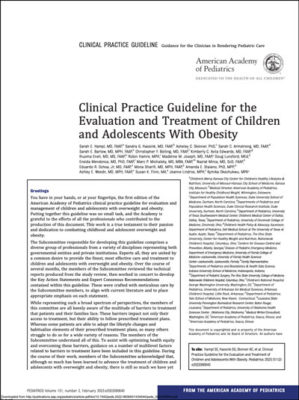 Less than 100 years ago, the federal government established the National School Lunch Program to combat what was seen as the most pressing childhood health concern of the day: undernutrition.
Less than 100 years ago, the federal government established the National School Lunch Program to combat what was seen as the most pressing childhood health concern of the day: undernutrition.
Today, the world is fundamentally different: Nearly one in five children between 2 and 19 in the U.S. have obesity—a rate that’s nearly quadrupled since the 1960s. Among specific communities (Mexican-American, American Indian and Alaskan Native), the rate is nearly 30%. This disturbing trend has myriad health and social consequences. Rates of childhood Type 2 diabetes and fatty liver disease—both strongly associated with obesity—are at all-time high rates. Kids with obesity are more likely to have depression and anxiety. Moreover, childhood obesity increases the risk for lifelong conditions like heart disease and stroke, as well as adult obesity.
In response to this reality, the American Academy of Pediatrics (AAP) just released its first-ever
Clinical Practice Guideline for the Evaluation and Treatment of Children and Adolescents With Obesity. The massive 100-page document aims to synthesize and assess current research on the drivers of childhood obesity and treatment strategies and give doctors a roadmap for diagnosing and addressing it in patients.
Here, we’ll unpack what the guidelines found, what we find encouraging, and where we see missed opportunities in what it says (and doesn’t say).
What is a Clinical Practice Guideline?
Before we evaluate the document, it’s helpful to understand the context of what it is meant to do and how it will be used.
Clinical practice guidelines (CPGs) are evidence-based recommendations for healthcare professionals designed to improve the quality of care and patient outcomes by standardizing the assessment and treatment of a condition. Typically, a panel of expert groups conducts a thorough review of the available scientific literature, grades the quality of the research, and produces recommendations rated from weak to strong based on that research synthesis. Depending on the condition, they can take years to develop. Examples of conditions for which clinical practice guidelines exist include hypertension, diabetes, and cancer. They can also provide guidance on preventive care strategies, such as vaccination schedules and screenings. Several studies suggest that guidelines improve patient outcomes.
However, given this development process, CPGs tend to represent a consensus view of mainstream medicine. And because of the effort involved, they also tend not to be updated rapidly or reflect new trends in treatment. CPGs are not rules—doctors don’t have to follow them. However, health systems may adopt guidelines they expect their clinicians to follow, so breaking with them may require justification—in short, they have inertia and help set the context for how a condition is discussed. Perhaps because of the sheer number of CPGs, evidence on their real-world effect is mixed: studies find that many improve clinical outcomes, while others find they are often not adhered to, are based on low-quality evidence, or have little impact on patient outcomes. However, at the very least, CPGs from prominent organizations like the AAP can generate a lot of attention, so it’s worth taking seriously what they say.
What the AAP Guidelines Say
This document is the first comprehensive CPG for childhood obesity. However, there have been shorter documents with a similar aim, including this 1997 paper and this 2007 document about the prevention of childhood obesity.
The AAP guidelines have two primary sections: 1) the causes, risk factors, and assessment of childhood obesity, and 2) the relationship of comorbidities to obesity (other conditions, such as diabetes, depression, or fatty liver disease). (It’s important to note that the guidelines explicitly don’t address obesity prevention, which the AAP says will come later in a separate statement.)
The most significant difference in the AAP guidelines from what came before is in the first section and the broad lens it takes on the causes of childhood obesity. In the introduction, the authors write, “Long stigmatized as a reversible consequence of personal choices, obesity has complex genetic, physiologic, socioeconomic, and environmental contributors. As the environment has become increasingly obesogenic, access to evidence-based treatment has become even more crucial.”
In that same vein, the guidelines label childhood obesity as a chronic disease. This has several implications [see below], but what the authors appear to want to communicate with this designation is that a) obesity has potential lifelong complications, both in the conditions, it can drive and in the increasing difficulty of reversing it as one ages; and b) pediatrics needs to take seriously the need to treat it as soon as possible. A “wait and see if they grow out of it” approach—common in earlier eras—is not sufficient.
The document dedicates sections to dozens of obesity drivers across categories like policy, community, home life, and individual factors, including:
- Marketing of unhealthy foods
- Lack of fresh food access
- Fast food proximity
- Access to safe physical activity
- Sugar-sweetened beverages
- Snacking behavior
- Screen time
- Sleep duration
- Environmental smoke exposure
- Psychosocial stress
- Adverse childhood experiences
- Genetic factors
- Parental obesity
- Gestational diabetes
- Birth weight
- Endocrine disorders
- Developmental and physical disabilities
- Depression
In addition, the guidelines acknowledge that while obesity is a chronic disease, “societal stigma around obesity results in pervasive weight bias” and gives recommendations on how to speak with children and their caregivers about their condition and how to treat it.
What this broad view means in practice is that treating obesity requires a highly individual approach. Where earlier guidelines focused almost exclusively on food and exercise (and parenting), this framework appreciates—through abundant research—that simply telling kids to snack less and move more won’t solve the problem.
Although the guidelines evaluate evidence around pharmaceutical and surgical interventions [more on this below], they focus heavily on the importance of what’s called Intensive Health Behavior and Lifestyle Treatment (IHBLT)—defined as “face-to-face, family-based counseling on nutrition and physical activity over at least a 3- to 12- month period.” But again, they find that the most successful interventions are a) customized to the child’s circumstances and b) long and personal: “The most effective programs include 26 or more hours of face-to-face, family-based, multicomponent treatment over a 2- to 12-month period.” Unfortunately, although this kind of treatment should be universally covered by insurance (per the Affordable Care Act), it often is not; further, kids in rural or underserved communities often don’t have easy access to this kind of treatment.
What the Guidelines Get Right
Recognizing the complex nature of obesity
Given the obesity treatment approaches of the past—blame the kid or the parents, or wait and see—it’s encouraging to see the AAP take so seriously the idea that childhood obesity is incredibly complex and individual, with many drivers. In a time when doctors simply don’t have as much time to spend with patients, truly unpacking the root cause of their illness, this document argues that when it comes to obesity, pediatricians have to dig deep and look at all possible factors.
Emphasizing Lifestyle Treatment
We’re also glad to see the emphasis on lifestyle treatment. In a time when weight loss drugs and quick fixes ping around social media, it’s too easy to turn to pharmaceuticals and surgery first. The guidelines spend a lot of time outlining the evidence-based parameters of lifestyle intervention treatment—that it should be in person, that more is generally better, and that it should be comprehensive.
Where the Guidelines Miss
Saying very little about food
Our most significant frustration with these guidelines is not what they say but what they don’t say. There is a distinct lack of specificity around nutrition as both a cause and a treatment of obesity.
The guidelines discuss nutrition-related risk factors, including portion sizes, snacking, and food marketing. “Marketing of unhealthy food and beverages directed at children tends to negatively impact their dietary choices and behaviors.” However, except for sugar-sweetened beverages, which show an overwhelming link to obesity, there are almost no mentions of specific kinds of foods and their relationship to obesity. In particular, there is no mention at all of ultra-processed foods, added sugars, or fructose as potential drivers of obesity despite evidence of their link.
Though the treatment section devotes ample space to lifestyle behavior interventions, it needs to make more specific recommendations related to nutrition. Instead, it simply lists a table with common dietary approaches. Still, even this table only cites the American Heart Association recommendation of “not more than 25 g (6 tsp) each day of added sugar” (far more added sugar than is optimal).
We hope that the forthcoming addition on obesity prevention will take the opportunity to dive deeper into some of these strategies—particularly around processed food and sugar—and look at the full breadth of research, not just large randomized trials.
Unfortunately, in leaving out nutrition guidance as a treatment lever, the guidelines rob pediatricians of the information they need to counsel patients—a worrisome omission, given that many families lack access to more advanced treatment and a pediatrician’s guidance may be their sole source of care.
The Problem with the “Chronic Disease” Framing
While there may be legitimate reasons to label pediatric obesity a chronic disease, there are also potentially dangerous implications. First, it introduces the idea of futility—if something is chronic, we can manage it but not cure it. Kids may even think they are ill or broken and will always need medical treatment. It undermines the notion that overweight and obesity are, in fact, readily reversible under the right conditions. It implies that we should expect that obesity is a condition that will require medical intervention in the long term. In a medical system built to treat problems, not solve issues at the root level and promote health, giving somebody a chronic disease label can set them on the course of a lifetime of pills and hospitalizations for associated conditions.
We would prefer a message that focuses on what families, doctors, and children can do—something like: “Obesity is a largely modifiable state that is a cellular and physiologic response to an obesogenic environment that is often modifiable, and it is the role of pediatricians and the AAP to do everything in their power to strategize with families to ameliorate the specific obesogenic factors contributing to obesity in a specific child.”
Too Cavalier with Drugs and Surgery
In addition to lifestyle intervention treatment, the guidelines assess the numerous obesity drugs available to adults, and despite finding weak evidence of efficacy and high evidence of side effects in children, goes on to suggest “Pediatricians and other PHCPs should offer adolescents 12 years and older with obesity weight loss pharmacotherapy, according to medication indications, risks, and benefits, as an adjunct to IHBLT.” Again, this might not be as concerning if our medical system didn’t already default to a pill-first approach, this might not be as concerning. But the risk here is that—faced with the significant hurdles of getting appropriate lifestyle intervention— pediatricians jump to the prescription pad and start kids as young as 12 on a lifelong journey of medicating a condition that, often, could be treated naturally.
The guidelines are slightly more cautious about bariatric surgery, recommending it only for kids with severe obesity—however, that still represents nearly 8% of children. The guidelines cite research suggesting that adolescent surgical intervention shows a “durable reduction” in BMI. However, they also note that as many as a quarter of people undergoing surgery may require additional procedures within five years. Worse, it cites “multiple micronutrient deficiencies following metabolic and bariatric surgery serve to highlight the need for routine and long-term monitoring.” In a document devoid of nutrition information, this breezing over potential long-term health consequences of this kind of intervention is troubling.
A Slio’d Approach to Associated Conditions
Including a section in the guidelines that addresses the comorbidities of obesity is a positive step forward. Obesity is implicated in so many other conditions that it can’t be treated as an isolated problem. Indeed, between 2002 and 2015, Type 2 diabetes among 10- to 19-year-olds in the United States increased by nearly 50%, while as of 2016, 1 in 5 kids between 12 and 18 have prediabetes. As many as a third of kids with obesity have fatty liver disease. The paper also looks at hypertension, sleep apnea, PCOS, and depression, among others.
Unfortunately, each of these conditions is discussed as a unique problem related to obesity without acknowledging shared root causes such as cellular damage or poor metabolic health (in fact, metabolic health is not mentioned at all in the guidelines). This is standard mainstream medical practice. Too often, it sends patients to several specialists who treat each condition independently, often with surgical or pharmaceutical interventions, rather than holistically addressing the underlying dysfunction.
The conclusion acknowledges, “It is important to recognize that treatment of obesity is integral to the treatment of its comorbidities and overweight or obesity and comorbidities should be treated concurrently.” We hope that future guidelines and statements will go further in recommending a root-cause approach to treating obesity.
Conflicts of Interest
Finally, while this is sadly not unique to this organization or document (several studies find the majority of CPGs have conflicts of interest), it is unconscionable that a medical group like the AAP can accept money from the manufacturers of a weight loss drug like semaglutide (Novo Nordisk) and then promote it in their guidelines. Undoubtedly, the individual practitioners working on these guidelines are doing their best to help make kids healthier. Still, even if this kind of blatant conflict of interest isn’t directly influencing the recommendations, at the very least, it undermines the public’s trust in guidelines and organizations like these.







